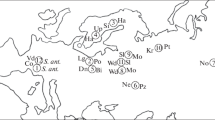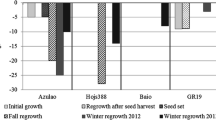Abstract
A review is presented of breeding peculiarities inHypericum perforatum L. and their consequences. This species is a tetraploid hybrid (2n=4x=32) which is assumed to be allopolyploid. It is a facultative apomict with apospory and pseudogamy. Original results of chromosome number variation amongstH. perforatum regenerants are presented, and their seed offspring were studied. The results suggest that genetic diversity occurs in this taxon resulting in great phenotypic variation. Various records of natural and artificial hybridization, as published by several authors, are discussed.
Similar content being viewed by others
References
Bougnicourt M. (1970): Polyembryonie chez l'Hypericum tetrapterumFries (=Hypericum acutumMoench).Bull. Soc. Bot. France 116: 495–504.
Bougnicourt M. (1971): Embryogénie des Hypericacées. Developpement de l'embryon chez l'Hypericum tetrapterumFries.Bull. Soc. Bot. France 118: 319–334.
Campbell M.H. &Delfosse E.S. (1984): The biology of Australian weeds. 13.Hypericum perforatum L.J. Austr. Inst. Agric. Sci. 1984: 63–73.
Ĉellárová E., Kimáková K. &Brutovská R. (1992): Multiple shoot formation and phenotypic changes inHypericum perforatum L.Acta Biotechnol. 12: 445–452.
Ĉellárová E., Daxnerová Z., Kimáková K. &Haluŝková J. (1994): The variability of the hypericin content in the regenerants ofHypericum perforatum.Acta Biotechnol. 14: 267–274.
Crackles F.E. (1990):Hypericum desetangsiiLamotte nm.desetangsii in Yorkshire, with special reference to its spread along railways.Watsonia 18: 63–67.
Crompton C.W., Hall I.V., Jensen K.I.N. &Hildebrand P.D. (1988): The biology of Canadian weeds. 83.Hypericum perforatum L.Canad. J. Pl. Sci. 68: 149–162.
Curtis J.D. &Lersten N.R. (1990): Internal secretory structures inHypericum (Clusiaceae): H. perforatum L. andH. balearicum L.New Phytol. 114: 571–580.
Czapik R. (1983): Embryological problems inRubus L. In:Erdelská O. (ed.),Fertilization and embryogenesis in ovulated plants, Veda, Bratislava, pp. 375–379.
Davis G.L. (1966):The systematic embryology of angiosperms. John Wiley & Sons, New York.
Fröhlich A. (1911): Der Formenkreis der ArtenHypericum perforatum L.H. maculatumCr. undH. acutumMnch. nebst deren Zwischenformen innerhalb des Gebietes von Europa.Sitzungsber. Kaiserl. Akad. Wiss., Math.-Naturwiss. Cl., Abt. 1. 120: 505–599.
Fröhlich A. (1915): Über zwei der Steiermark eigentümliche Formen aus dem Verwandtschaftskreis desHypericum maculatumCr.Mitt. Naturwiss. Vereines Steiermark 51: 216–245.
Fröhlich A. (1960): Kříženci třezalek (Hypericum) v ĈSR (Hybrids of St. John's Wort (Hypericum) in Czechoslovakia).Preslia 32: 97–99.
Gorškova S.G. (1949): Sem. CII. Zverobojnye—GuttiferaeJuss. In:ŜiŝkinB.K. &BobrovE.G. (eds.),Flora SSSR 15 (Flora of the USSR), Izdatel'stvo Akademii Nauk, Moskva, Leningrad, pp. 201–258.
Hanna W.W. (1995): Use of apomixis in cultivar development.Advances Agron. 54: 333–350.
Hagemann I. (1983): Wuchsformenuntersuchungen an zentraleuropäischenHypericum-Arten.Flora 173: 97–142.
Hoar C.S. (1931): Meiosis inHypericum punctatum.Bot. Gaz. 92: 396–406.
Hoar C.S. &Haertl E.J. (1932): Meiosis in the genusHypericum.Bot. Gaz. 93: 197–204.
Izmaiłow R. (1967): Observations in embryo and endosperm development in various chromosomic types of the apomictic speciesRanunculus cassubicus L.Acta Biol. Cracov., Ser. Bot. 10: 99–111.
Kearns C.A. &Inouye D.W. (1993):Techniques for pollination biologists. University Press of Colorado, Niwot.
Lubbers E.L., Arthur L., Hanna W.W. &Ozias-Akins P. (1994): Molecular markers shared by diverse apomicticPennisetum species.Theor. Appl. Genet. 89: 636–642.
Mártonfi P., Repĉák M. &Mihoková L. (1996):Hypericum maculatumCrantz subsp.maculatum × H. perforatum L. (Hypericaceae): corroboration of natural hybridization inHypericum by secondary metabolite analysis.Folia Geobot. Phytotax. 31: 245–250.
Mogie M. (1992):The evolution of asexual reproduction in plants. Chapman & Hall, London.
Noack K.L. (1939): ÜberHypericum-Kreuzungen. VI. Fortpflanzungsverhältnisse und Bastarde vonH. perforatum L.Z. Indukt. Abstammungs-Vererbungsl. 76: 569–601.
Noack K.L. (1941): Geschlechtsverlust und Bastardierung beim Johanniskraut.Forsch. & Fortschr. 17: 13–15
Nogler G.A. (1984): Gametophytic apomixis. In:Johri B.M. (ed.),Embryology of angiosperms, Springer-Verlag, Berlin, pp. 475–518.
Nybom H., Schaal B.A. &Rogstad S.H. (1989): DNA “fingerprints” can distinguish cultivars of blackberries and raspberries.Acta Hort. 262: 305–310.
Prakash N. &Lau Y.Y. (1976): Morphology ofPloiarium alternifolium and the taxonomic position ofPloiarium.Bot. Not. 129: 279–285.
Robson N.K.B. (1958):Hypericum maculatum in Britain and Europe.Bot. Soc. Brit. Isles Proc. 3: 99–100.
Robson N.K.B. (1972):Hypericum desetangsii.Watsonia 9: 203.
Robson N.K.B. (1975): 115.Hypericum L. In:Stace C.A. (ed.),Hybridization and the flora of the British Isles, Academic Press, London, pp. 164–167.
Robson N.K.B. (1977): Studies in the genusHypericum L. (Guttiferae) 1. Infrageneric classification.Bull. Brit. Mus. Nat. Hist., Bot. 5: 291–355.
Robson N.K.B. (1981): Studies in the genusHypericum L. (Guttiferae) 2. Characters of the genus.Bull. Brit. Mus. Nat. Hist., Bot. 8: 55–226.
Robson N.K.B. &Adams P. (1968): Chromosome numbers inHypericum and related genera.Brittonia 20: 95–106.
Rutishauser A. (1954): Die Entwicklungserregung des Endosperms bei pseudogamenRanunculus-Arten.Mitt. Naturf. Ges. Schaffhausen 25: 1–45.
Schwarz O. (1965): Die kritischenHypericum-Arten der mitteleuropäischen Flora.Drudea 5: 59–66.
Ŝiŝkinskaja N.A. (1983): Cytoembryological investigation of apomixis in weed grass species. In:Erdelská O. (ed.),Fertilization and embryogenesis in ovulated plants, Veda, Bratislava, pp. 363–365.
Takhtajan A. (ed.) (1990):Ĉisla chromosom cvetkovych rastenij flory SSR, Aceraceae—Menyanthaceae(Chromosome numbers of flowering plants of the flora of the USSR Aceraceae—Menyanthaceae). Nauka, Leningrad.
Tisdale E.W., Hironaka M. &Pringle W.L. (1959): Observations on the autecology ofHypericum perforatum.Ecology 40: 54–62.
Yang C.-S. (1981):Guttiferae. In:Fu K.-T. &Chang C.-W. (eds.),Flora Tsinlingensis 1/3, Science Press, Beijing, pp. 302–307.
Zelený V. (1990): 58.HypericaceaeJuss.—třezalkovité. In:HejnýS. &SlavíkB. (eds.),Kvêtena Ĉeské republiky 2(Flora of the Czech Republic) Academia, Praha, pp. 376–389.
Author information
Authors and Affiliations
Rights and permissions
About this article
Cite this article
Mártonfi, P., Brutovská, R., Ĉellárová, E. et al. Apomixis and hybridity inHypericum perforatum . Folia Geobot 31, 389–396 (1996). https://doi.org/10.1007/BF02815383
Issue Date:
DOI: https://doi.org/10.1007/BF02815383




